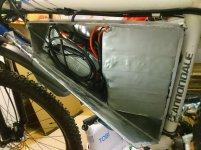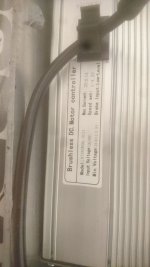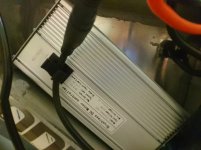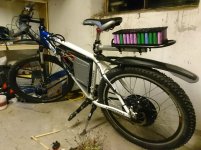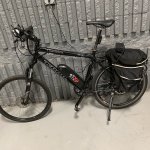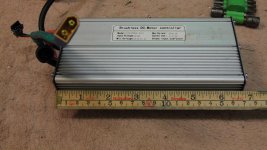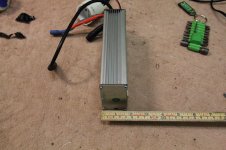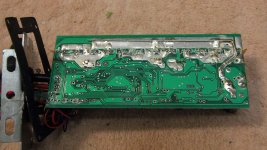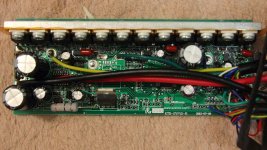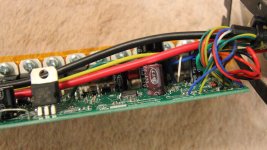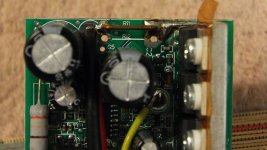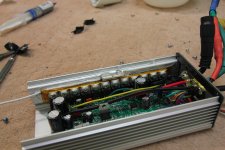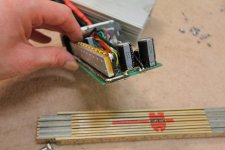Jan-Erik-86
100 W
- Joined
- Jan 23, 2019
- Messages
- 110
Hi,
I currently have an unknown 1000W DD hub motor from ebay, and all i know about it is that it's old, and the guy I bought it from say he think it's a 4T motor.
The controller is a 48V 26A max KT controller, and from the model name i assume it's a 21A rated controller? It's a simple square wave, and from the size and current rating I assume it's probably a 12-fet, but i've not been able to verify this yet as it's currently glued stuck.
I use an LCD3 display, and during load i get a reading of around 1100W with a 13s battery fully charged.
I've attached some pics, so if anyone recognize what motor and controller i have and have more details about them that would be great!
In general I'm OK with my current max speed of around 45km/h with a fully charged battery and usually cruise around 25-35km/h anyway, but what i wish for is some more power for short steep hills and acceleration. I'm hoping for something in the 2kw range.
I've been doing some searching, and figured that other then changing my battery from a 13s to a 14s (planned upgrade), the first step for more power would be the controller, and my plan here was mainly one of two:
1: Shunt mod it for more current, and If the stock fets are poor, replace them with IRFB3077 - which I hope 12 of should handle 2+kw?
2: Replace my current controller with a 45A max 18-fet sine controller.
While a controller replacement would be the quickest and easiest, a shunt mod and fet replacement won't be difficult either, and would allow me to still use my physically smaller controller. Being awere the downside would be square wave instead of sine, 12-fet vs 18-fet (but at least the 12 fets would be good quality), and incorrect power reading on the LCD3 display, I would still prefer this option if possible?
But then is the other question - will the motor likely handle it? I know i should probably upgrade the phase wires, but will it be enough to upgrade them until right outside the motor, or will i need to replace them all the way to the inside of the motor?
As for cooling the motor, I will be adding ferrofluid, and maybe cooling fins if needed.
Note that i don't live in a very hilly area, and i won't be needing full power for long periods, usually no more then 30 sec.
Hopefully someone can point me in the right direction here...
I currently have an unknown 1000W DD hub motor from ebay, and all i know about it is that it's old, and the guy I bought it from say he think it's a 4T motor.
The controller is a 48V 26A max KT controller, and from the model name i assume it's a 21A rated controller? It's a simple square wave, and from the size and current rating I assume it's probably a 12-fet, but i've not been able to verify this yet as it's currently glued stuck.
I use an LCD3 display, and during load i get a reading of around 1100W with a 13s battery fully charged.
I've attached some pics, so if anyone recognize what motor and controller i have and have more details about them that would be great!
In general I'm OK with my current max speed of around 45km/h with a fully charged battery and usually cruise around 25-35km/h anyway, but what i wish for is some more power for short steep hills and acceleration. I'm hoping for something in the 2kw range.
I've been doing some searching, and figured that other then changing my battery from a 13s to a 14s (planned upgrade), the first step for more power would be the controller, and my plan here was mainly one of two:
1: Shunt mod it for more current, and If the stock fets are poor, replace them with IRFB3077 - which I hope 12 of should handle 2+kw?
2: Replace my current controller with a 45A max 18-fet sine controller.
While a controller replacement would be the quickest and easiest, a shunt mod and fet replacement won't be difficult either, and would allow me to still use my physically smaller controller. Being awere the downside would be square wave instead of sine, 12-fet vs 18-fet (but at least the 12 fets would be good quality), and incorrect power reading on the LCD3 display, I would still prefer this option if possible?
But then is the other question - will the motor likely handle it? I know i should probably upgrade the phase wires, but will it be enough to upgrade them until right outside the motor, or will i need to replace them all the way to the inside of the motor?
As for cooling the motor, I will be adding ferrofluid, and maybe cooling fins if needed.
Note that i don't live in a very hilly area, and i won't be needing full power for long periods, usually no more then 30 sec.
Hopefully someone can point me in the right direction here...


